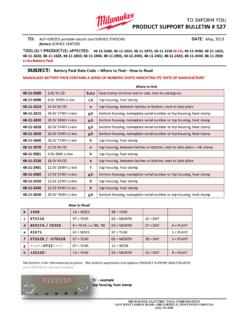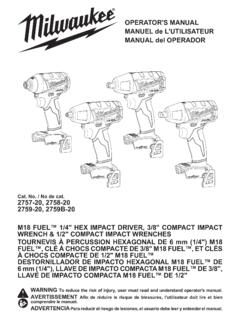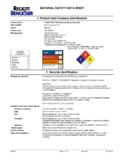Transcription of May be used to comply with OSHA’s Hazard Communication ...
1 Page 1 of 8 58 97 0500 Lithium ion Battery Rechargeable 12A section 1: product AND company identification product Name: Lithium ion Batteries Rechargeable Drawing Number: 58 97 0500 Issue Date: January 2018 Supersedes Date: April 2016 milwaukee Electric Tool Corporation company Phone Number: 262 781 3600 or 13135 West Lisbon Road 1 800 729 3878 Brookfield, Wisconsin USA 53005 2550 Emergency Contact Number: 1 800 424 9300 Chemtrec: United States only For International: +1 703 741 5970 section 2: HAZARDS identification Health EnvironmentalPhysicalEye Irritation: No classified hazards Acute Toxicity: No classified hazardsFlammable liquid: No classified hazardsSkin Irritation: No classified hazards Chronic Toxicity: No classified hazardsAcute Toxicity, Oral: No classified hazards Acute Toxicity, Inhalation: No classified hazards GHS Label No applicable labeling Hazard Statements Precautionary StatementsNo exposure during routine handling of product CLASSIFIED HAZARDS This material is not hazardous under the criteria of the Federal OSHA Hazard Communication Standard 29 CFR This SDS contains valuable information for the safe handling and proper use of this product .
2 Save this SDS for future reference. OTHER HAZARDS Flammable: Organic components will burn if cell is incinerated. Combustion of cell contents may cause evolution of Hydrogen Fluoride. Potential Health Effects: Fluoride interferes with nerve impulse conduction causing severe pain or absence of sensations WARNING: No exposure during routine handling of product . Hydrofluoric Acid exposure during firefighting: This information is given for the use of professional fire fighters responding to a warehouse fire where fire from other materials may incinerate batteries. This section is provided solely in case of exposure, during firefighting, to the combustion by products. ProductInformationSheet May be used to comply with OSHA s Hazard Communication Standard 29 CFR This standard must be consulted for specific requirements. Page 2 of 8 58 97 0500 Lithium ion Battery Rechargeable 12A section 3: COMPOSITION /INFORMATION OF INGREDIENTS Chemical Name CAS #ConcentrationAluminum Foil 7429 90 10 Biphenyl (BP) 92 52 Foil 7440 50 8 10 Linear & Cyclic Carbonate solvents N/A 0 17 Graphite Powder/Carbon 7440 44 010 30 Metal Oxide or other Electrolyte (proprietary)Confidential10 50 Lithium Hexaflurophosphate (LiPF6) 21324 40 30 5 Polyvinylidene Flouride (PVDF) 24937 79 5 Styrene Butadiene Rubber (SBR) N/A <5 Aluminum, Steel, Nickel and other inert materials N/A Remainder section 4: FIRST AID MEASURES No exposure during routine handling of product .
3 Risk of exposure occurs only if the battery is mechanically or electrically abused. No effect under routine handling and use to eyes, skin or if inhaled. Ingestion is not likely, given the physical size and state of the cell. If swallowed, seek medical attention immediately. If exposure to internal materials within cell due to damaged outer casing the following actions are recommended: EYE CONTACT: Flush with water for 15 minutes without rubbing and immediately seek medical attention. SKIN CONTACT: Wash area immediately with soap and water. If irritation continues see medical attention. INHALATION: Leave area immediately and move to fresh air and seek medical attention. INGESTION: If swallowed, contact POISON CONTROL CENTER immediately. section 5: FIRE FIGHTING MEASURES NFPA 704 Hazard Class HMIS SUITABLE EXTINGUISHING MEDIA: Water spray, carbon dioxide, dry chemical powder or appropriate foam. Use agent appropriate for surrounding materials.
4 UNSUITABLE EXTINGUISHING MEDIA: None. Page 3 of 8 58 97 0500 Lithium ion Battery Rechargeable 12A PRODUCTS OF COMBUSTION: Organic components will burn if incinerated. Combustion of cell contents may cause evolution of Hydrogen Fluoride. In case of fire in an adjacent area, use water, CO2, or dry chemical extinguishers if cells are packed in their original containers since the fuel of the fire is basically paper products. PROTECTION OF FIREFIGHTERS: Hydrofluoric Acid exposure during firefighting: This information is given for the use of professional fire fighters responding to a warehouse fire where fire from other materials may incinerate batteries. This section is provided solely in case of exposure, during firefighting, to the combustion by products. section 6: ACCIDENTAL RELEASE MEASURES PERSONAL PRECAUTIONS: Use standard industrial clothing in normal use. If handling large containers of cells wear steel toed footwear. ENVIRONMENTAL PRECAUTIONS: No special precautions necessary.
5 METHODS FOR CONTAINMENT: Transport container outdoors. Hold burned cells and fire cleanup solids for disposal as potential hazardous waste. Unburned cells are not hazardous waste. A fire with over 100 kg of cells burnt will likely require reporting to environmental officials. Always consult and obey all international, federal and local environmental laws. METHODS FOR CLEAN UP: No data available OTHER INFORMATION: No data available section 7: HANDLING AND STORAGE HANDLING: Use only approved charging equipment. Do not disassemble battery or battery pack. Do not puncture, crush or dispose of in fire. STORAGE: Store in a cool, dry place away from sparks and flame. Keep below 125 C. Keep above 60 C. Charge between 0 C and 45 C. section 8: EXPOSURE CONTROLS/PERSONAL PROTECTION Chemical Name OSHAPEL ACGIHTLV California Prop 65 Reg. Y/N IARC/NTPY/N Aluminum Foil TWA5mg/m3* TWA5mg/m3* N NBiphenyl (BP)NANAN NCopper Foil NANAN NLinear & Cyclic Carbonate solvents NANAN NGraphite Powder/Carbon NANAN NMetal Oxide or other Electrolyte (proprietary)NANAN NLithium Hexaflurophosphate (LiPF6) NANAN N Page 4 of 8 58 97 0500 Lithium ion Battery Rechargeable 12A Polyvinylidene Flouride (PVDF) NANAN NStyrene Butadiene Rubber (SBR) NANAN NAluminum, Steel, Nickel and other inert materials NANAN N EYE PROTECTION: Not necessary under conditions of normal use SKIN PROTECTION: Not necessary under conditions of normal use RESPIRATORY PROTECTION: Not necessary under conditions of normal use ENGINEERING CONTROLS: Not necessary under conditions of normal use GENERAL HYGIENE CONSIDERATIONS: Not necessary under conditions of normal use EXPOSURE GUIDELINES: Not necessary under conditions of normal use section 9.
6 PHYSICAL AND CHEMICAL PROPERTIES Data represent typical values and are not intended to be specifications. NA=Not Applicable; ND=Not Determined Physical state: .. Solid Viscosity: .. NA Colour: .. NA Upper Explosive Limits (vol % in air): .. NA Odor: .. Odorless Lower Explosive Limits (vol % in air): .. NA Odor Threshold: .. NA Vapor pressure: .. NA pH: .. NA Vapor density: .. NA Melting/Freezing Point: .. NA Relative density: .. NA VOC Content: .. NA Solubility: .. NA Boiling Point: .. NA Partition Coefficient: .. NA Flash Point: .. NA Auto ignition Temperature: .. NA Evaporation Rate:.. NA Decomposition Temperature: .. NA Specific Gravity: .. NA Flammability (solid, gas): .. Organic components will burn if cell is incinerated section 10: STABILITY AND REACTIVITY INCOMPATIBLE MATERIALS: Water, heat and strong acids. DECOMPOSITION PRODUCTS MAY INCLUDE: Hydrogen Fluoride, Phosphorus Oxides, Carbon Monoxide, Carbon Dioxide, Lithium Hydroxide, Manganese Oxides, Aluminum Oxide, possible fluoro compounds, Carbon soot.
7 CONDITIONS TO AVOID: Do not crush, puncture, incinerate, immerse in water or heat over 212 F (100 C). Steel casing slowly dissolves in strong mineral acids. Page 5 of 8 58 97 0500 Lithium ion Battery Rechargeable 12A POLYMERIZATION: Hazardous polymerization will not occur. Spontaneous decomposition will not occur at normal temperature. CHEMICAL STABILITY: This product is stable. REACTIVITY: Hazardous polymerization will not occur. Spontaneous decomposition will not occur at normal temperature. section 11: TOXICOLOGY INFORMATION LIKELY ROUTES OF EXPOSURE: Inhalation, Eye and Skin contact Eye contact, skin contact, skin absorption, inhalation only if burned. Hydrofluoric acid is extremely corrosive. Contact with hydrogen fluoride fumes is to be avoided. Permissible exposure limit is 3ppm. In case of contact with hydrogen fluoride fumes, immediately leave the area and seek first aid and emergency medical attention. Symptoms may have delayed onset.
8 Fluoride ions penetrate skin readily causing destruction of deep tissue layers even bone. Fluoride interferes with nerve impulse conduction causing severe pain or absence of sensations. Immediately flush eyes or skin with water for at least 20 minutes to neutralize the acidity and remove some fluoride. Remove and destroy all contaminated clothing and permeable personal possessions. Before re use, impermeable possessions should be soaked in benzalkonium chloride after washing. Following flushing of the affected areas, an iced aqueous solution of benzalkonium chloride or calcium gluconate gel should be applied to react with the fluoride ion. Compresses and wraps may be used for areas where immersion is not practical. Medicated dressing should be changed every 2 minutes. Exposure to hydrofluoric acid fumes sufficient to cause pain requires immediate hospitalization for monitoring for pulmonary edema. ACUTE SYMPTOMS AND EFFECTS: Inhalation: No further toxicological data known Eye contact: No further toxicological data known Skin contact: No further toxicological data known Ingestion: No further toxicological data known OTHER: No further data known.
9 section 12: ECOLOGICAL INFORMATION ECOTOXICOLOGICAL INFORMATION: None in routine handling of product . TOXICITY: No data available PERSISTENCE AND DEGRADABILITY (BIOPERSISTENCY & BIODEGRADABILITY): None in routine handling of product . POTENTIAL OF BIOACCUMULATION: None in routine handling of product . MOBILITY IN SOIL: None in routine handling of product . OTHER ADVERSE EFFECTS: No data available Page 6 of 8 58 97 0500 Lithium ion Battery Rechargeable 12A section 13: DISPOSAL CONSIDERATIONS DISPOSAL: Dispose in accordance with appropriate regulations. Always consult and obey all international, federal, provincial/state and local hazardous waste disposal laws. Some jurisdictions require recycling of this spent product . Battery recycling is encouraged. Lithium ion batteries are safe for disposal in the normal municipal waste stream since they are not defined by the federal government as hazardous waste. However, Lithium ion batteries are recyclable.
10 This product does not contain mercury, cadmium or Lithium (metal). DO NOT INCINERATE or subject battery cells to temperatures in excess of 212 F (100 C). section 14: TRANSPORTATION INFORMATION DOT HAZARDOUS MATERIAL REGULATIONS (RE: GROUND TRANSPORT) Proper Shipping Description: UN3480 Lithium ion batteries; UN3481 Lithium ion batteries packed with or contained in equipment; Class 9. milwaukee Lithium ion batteries are to be shipped in compliance with relevant requirements of HMR 49 . CANADA TRANSPORT DANGEROUS GOODS (RE: GROUND TRANSPORT) Proper Shipping Description: UN3480 Lithium ion batteries; UN3481 Lithium ion batteries packed with or contained in equipment; Class 9. milwaukee Lithium ion batteries are to be shipped in compliance with relevant requirements of TDG Part 2 ( section ), or TDG Schedule 2 (Special Provision 34), as applicable. INTERNATIONAL DANGEROUS GOODS REGULATIONS (RE: AIR, SEA, GROUND TRANSPORT) Proper Shipping Description: UN3480 Lithium ion batteries; UN3481 Lithium ion batteries packed with or contained in equipment; Class 9.












